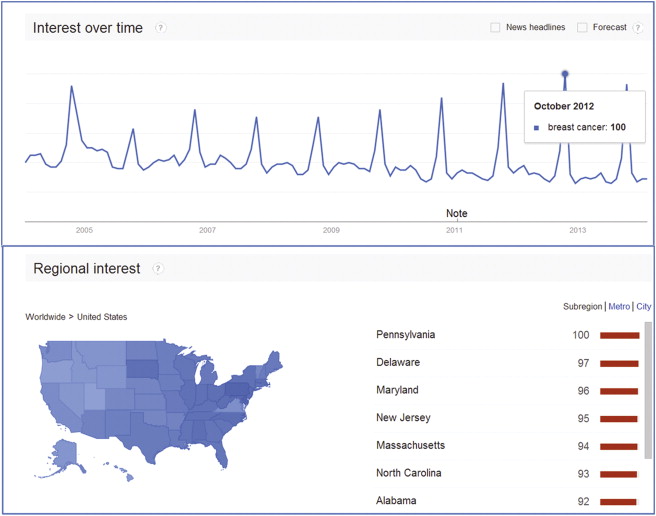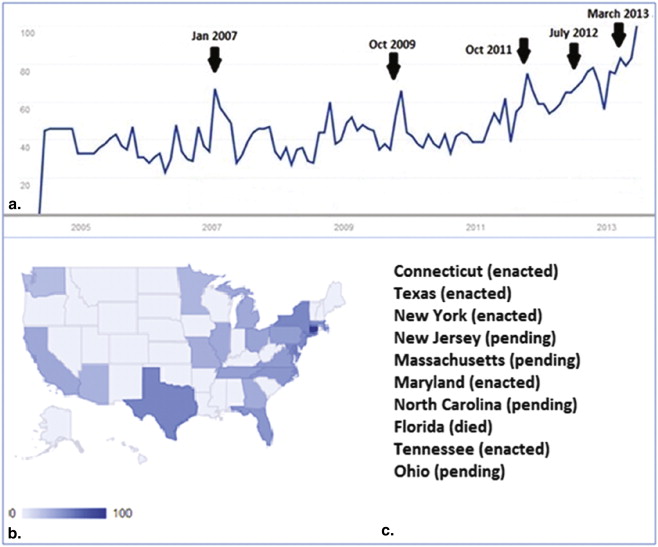Rationale and Objectives
Millions of people use online search engines everyday to find health-related information and voluntarily share their personal health status and behaviors in various Web sites. Thus, data from tracking of online information seeker’s behavior offer potential opportunities for use in public health surveillance and research. Google Trends is a feature of Google which allows Internet users to graph the frequency of searches for a single term or phrase over time or by geographic region. We used Google Trends to describe patterns of information-seeking behavior in the subject of dense breasts and to examine their correlation with the passage or introduction of dense breast notification legislation.
Materials and Methods
To capture the temporal variations of information seeking about dense breasts, the Web search query “dense breast” was entered in the Google Trends tool. We then mapped the dates of legislative actions regarding dense breasts that received widespread coverage in the lay media to information-seeking trends about dense breasts over time.
Results
Newsworthy events and legislative actions appear to correlate well with peaks in search volume of “dense breast”. Geographic regions with the highest search volumes have passed, denied, or are currently considering the dense breast legislation.
Conclusions
Our study demonstrated that any legislative action and respective news coverage correlate with increase in information seeking for “dense breast” on Google, suggesting that Google Trends has the potential to serve as a data source for policy-relevant research.
Widespread access to the Internet in last few decades has made online social media and digital technologies one of the major sources of public information. Millions of people use online search engines (eg, Google) everyday to find health-related information and voluntarily share their personal health status and behaviors in various Web sites (social networking sites, online disease support groups, and so forth.). Such data from tracking of online information seeker’s behavior offer potential opportunities for use in public health surveillance and research . A specific example of this is the examination of Google use patterns to understand timely public health issues including infectious disease hotspots, as has been shown in influenza .
Google Trends (available at http://google.com/trends/ ) is a feature of Google which allows Internet users to graph the frequency of searches for a single term or phrase. The fluctuations in the graph reflect changes in information seekers’ querying or use of the search term over time. Google Trends further provides options to compare graphs for different search terms or analyze regional differences for a specific term. Google Trends (or Google insights, the previous similar Google tool) has been primarily used as a real-time surveillance system for tracking infectious diseases such as Lyme disease , tuberculosis , and dengue . Although Google Trends has potential implications for as a tool for surveillance and research on a variety of health topics, search query surveillance for noninfectious diseases such as chronic disease or preventive health issues , and especially for women’s health issues, has not been widely used. Therefore, we sought to demonstrate the use of Google Trends evaluating a current “hot topic” in women’s health—breast cancer screening.
Get Radiology Tree app to read full this article<
Materials and methods
Overview of Google Trends Methodology Using “Breast Cancer” as an Example
Get Radiology Tree app to read full this article<
Get Radiology Tree app to read full this article<
Get Radiology Tree app to read full this article<
An Application of Google Trends to “Dense Breast”
Get Radiology Tree app to read full this article<
Get Radiology Tree app to read full this article<
Get Radiology Tree app to read full this article<
Get Radiology Tree app to read full this article<
Results
Get Radiology Tree app to read full this article<
Discussion
Get Radiology Tree app to read full this article<
Get Radiology Tree app to read full this article<
Get Radiology Tree app to read full this article<
Get Radiology Tree app to read full this article<
Conclusions
Get Radiology Tree app to read full this article<
Get Radiology Tree app to read full this article<
References
1. Eysenbach G.: Infodemiology and infoveillance tracking online health information and cyberbehavior for public health. Am J Prev Med 2011; 40: pp. S154-S158. PMID: 21521589
2. Chew C., Eysenbach G.: Pandemics in the age of Twitter: content analysis of Tweets during the 2009 H1N1 outbreak. PLoS One 2010; 5: pp. e14118. PMID: 21124761
3. Ginsberg J., Mohebbi M.H., Patel R.S., et. al.: Detecting influenza epidemics using search engine query data. Nature 2009; 457: pp. 1012-1014. PMID: 19020500
4. Valdivia A., Lopez-Alcalde J., Vicente M., et. al.: Monitoring influenza activity in Europe with Google Flu Trends: comparison with the findings of sentinel physician networks - results for 2009-10. Euro Surveill 2010 Jul 22; 15: PMID: 20667303
5. Seifter A., Schwarzwalder A., Geis K., et. al.: The utility of “Google Trends” for epidemiological research: Lyme disease as an example. Geospat health 2010; 4: pp. 135-137. PMID: 20503183
6. Zhou X., Ye J., Feng Y.: Tuberculosis surveillance by analyzing Google Trends. IEEE Trans Biomed Eng 2011 Aug; 58: PMID: 21435969
7. Althouse B.M., Ng Y.Y., Cummings D.A.: Prediction of dengue incidence using search query surveillance. PLoS Negl Trop Dis 2011; 5: e1258. PMID: 21829744
8. Ayers J.W., Althouse B.M., Allem J.P., et. al.: Seasonality in seeking mental health information on Google. Am J Prev Med 2013; 44: pp. 520-525. PMID: 23597817
9. Ayers J.W., Ribisl K.M., Brownstein J.S.: Tracking the rise in popularity of electronic nicotine delivery systems (electronic cigarettes) using search query surveillance. Am J Prev Med 2011; 40: pp. 448-453. PMID: 21406279
10. Ayers J.W., Althouse B.M., Allem J.P., et. al.: A novel evaluation of World No Tobacco day in Latin America. J Med Internet Res 2012; 14: pp. e77. PMID: 22634568
11. Boyd N.F., Guo H., Martin L.J., et. al.: Mammographic density and the risk and detection of breast cancer. N Engl J Med 2007; 356: pp. 227-236. PMID: 17229950
12. Dehkordy S.F., Carlos R.: Dense breast legislation in the United States: state of the states. J Am Coll Radiol 2013; 10: pp. 899-902. PMID: 24295937
13. Huang J., Zheng R., Emery S.: Assessing the impact of the national smoking ban in indoor public places in china: evidence from quit smoking related online searches. PLoS One 2013; 8: pp. e65577. PMID: 23776504
14. New law may help women with dense breasts. NBC Connecticut. Available at: http://goo.gl/11dcZ . Accessed July, 2013.
15. Vozzella L. Breast-density bill to become law in Virginia. The Washington Post. Available at: http://goo.gl/BgL0D . Accessed July, 2013.
16. NY bill would notify women of dense breast tissue. CBS. Available at: http://goo.gl/0PDwH . Accessed July, 2013.
17. Grady D. New laws add a divisive component to breast screening. The New York Times. Available at: http://goo.gl/FHSrB . Accessed July, 2013.
18. Hutchison C. Should women be warned about breast density? Docs Weigh In. ABC News. Available at: http://goo.gl/K3vda . Accessed July, 2013.
19. Colliver V. New mammography law on breast density. San Francisco Chronicle. Available at: http://goo.gl/dcSnY . Accessed July, 2013.
20. Hitti M. Breast density, cancer risk?.CBCNEWS. Available at: http://www.cbsnews.com/stories/2007/01/17/health/webmd/main2369559.shtml . Accessed July, 2013.
21. Dense breast tissue hikes risk of cancer. Available at: NBCNews. http://goo.gl/M2Up6 . Accessed July, 2013.

